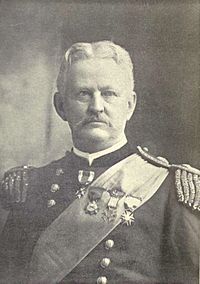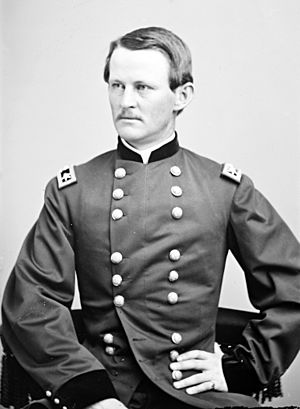Wesley Merritt facts for kids
Quick facts for kids
Wesley Merritt
|
|
|---|---|

Major General Wesley Merritt, 1st American Governor General of the Philippines
|
|
| 1st American Military Governor of the Philippines | |
| In office August 14, 1898 – August 30, 1898 |
|
| Preceded by | Position established Diego de los Ríos as Governor-General of the Philippines |
| Succeeded by | Elwell Stephen Otis |
| Personal details | |
| Born | June 16, 1836 New York City, New York, U.S. |
| Died | December 3, 1910 (aged 74) Natural Bridge, Virginia, U.S. |
| Spouses | Caroline Warren Merritt (1849 – June 12, 1893); Laura Williams Merritt |
| Military career | |
| Allegiance | United States of America |
| Service/ |
United States Army Union Army |
| Years of service | 1860–1900 |
| Rank | |
| Battles/wars | American Civil War Indian Wars Spanish–American War Philippine–American War |
Wesley Merritt (June 16, 1836 – December 3, 1910) was an American major general and a brave soldier. He served in the United States Army's cavalry (soldiers who fight on horseback). He fought in several important wars. These included the American Civil War, the American Indian Wars, and the Spanish–American War. After the Spanish-American War, he became the first American Military Governor of the Philippines.
Contents
Early Life and Military Training
Wesley Merritt was born in New York City. He went to the United States Military Academy (West Point). This is a famous school for training army officers. He graduated in 1860. After graduating, he became a second lieutenant. He joined the 2nd Dragoons, a cavalry unit. He served in Utah and later became the adjutant (an assistant officer) for his unit.
Fighting in the Civil War
In 1862, Merritt became a captain. He worked as an aide to Brigadier General Philip St. George Cooke. Cooke led the cavalry for the Army of the Potomac. Merritt helped defend Washington, D.C. in 1862.
In 1863, he joined Major General George Stoneman's team. He took part in Stoneman's Raid during the Battle of Chancellorsville.
Gettysburg Campaign
During the Gettysburg Campaign, Merritt led a special cavalry group. He was slightly hurt in the Battle of Brandy Station. On June 29, 1863, he was promoted to brigadier general. This was a big jump from captain. It was for his "gallant and meritorious service" (brave and excellent work). Two other captains, Elon J. Farnsworth and George Armstrong Custer, also got this special promotion that day.
Merritt's group did not fight in the first cavalry battles at Gettysburg. They guarded the army's supply lines. But on July 3, 1863, he joined an attack. This attack was against the Confederate army's right side. His fellow general, Elon J. Farnsworth, died in this attack.
After December 1863, Merritt took over command of the 1st Division of the Cavalry Corps. This happened after its leader, John Buford, died. Merritt also led this division for most of Lieutenant General Ulysses S. Grant's Overland Campaign in 1864. He was promoted again for his actions at the Battle of Yellow Tavern. In this battle, a famous Confederate cavalry leader, J.E.B. Stuart, was killed.
Later Civil War Actions
During Major General Philip Sheridan's Valley Campaigns of 1864, Merritt led the 1st Division of the Cavalry Corps. His division helped defeat the Confederate forces at the Third Battle of Winchester. For this, he was promoted to major general of the volunteers. His cavalry then destroyed many farms and supplies in the valley. This was to prevent the enemy from using them.
Merritt was second-in-command to Sheridan during the Appomattox Campaign. He helped with the surrender at Appomattox Court House. In April 1865, he was promoted to major general in the regular army. This was for his bravery at the Battle of Five Forks and the Appomattox Campaign.
After the war, in June 1865, Merritt led cavalry forces in the Southwest. He led a long march of 600 miles from Shreveport, Louisiana, to San Antonio, Texas. This was part of the Union army's occupation. In January 1866, he returned to his pre-war rank in the regular army.
Life After the Civil War
After the Civil War, Merritt continued to serve in the cavalry. He worked along the frontier (the western parts of the United States). In 1866, he became a lieutenant colonel in the 9th Cavalry. He commanded Fort Davis, Texas, in 1867.
In 1876, he became a colonel of the 5th Cavalry. He led them in the Battle of Slim Buttes during the Indian Wars.
Merritt was also part of a group that looked into the actions of Major Marcus Reno at the Battle of the Little Bighorn. This battle led to the death of General George Armstrong Custer.
From 1882 to 1887, Merritt was the superintendent of West Point. This means he was in charge of the military academy where he had studied. In 1887, he became a brigadier general in the Regular Army. He was promoted to major general in the U.S. Army in 1895.
Spanish–American War and Philippines
In 1898, Commodore Dewey's navy defeated the Spanish fleet in Manila Bay. The United States then decided to send ground troops to capture the city of Manila. Merritt was chosen to lead these troops, called the Eighth Army Corps. In June 1898, Merritt and his soldiers sailed from San Francisco to the Philippines.
When Merritt arrived in Manila, he and Dewey planned the attack on the city. They did not tell Emilio Aguinaldo, a Filipino leader, about their plans. The Americans did not want Aguinaldo's forces to control the city. Merritt and Dewey secretly arranged with the Spanish governor to surrender Manila. The city fell to the Americans on August 13, 1898.
After the city was captured, Merritt became the first American military governor of the Philippines. He was replaced by Major General Elwell Stephen Otis on August 30. Merritt then went to advise the U.S. team during the peace talks. These talks led to the Treaty of Paris.
Family and Later Life
Wesley Merritt was married two times. His first wife was Caroline Warren Merritt. She passed away in 1893. His second wife was Laura Williams Caton. They married in London in 1898.
General Merritt retired from the Army in 1900. He died in Natural Bridge, Virginia, on December 3, 1910, at age 74. He is buried at West Point Cemetery.
Portrayal in Media
- Wesley Merritt was played by Greg Dorris in the Filipino movie, Heneral Luna (2015).
See also
 In Spanish: Wesley Merritt para niños
In Spanish: Wesley Merritt para niños


